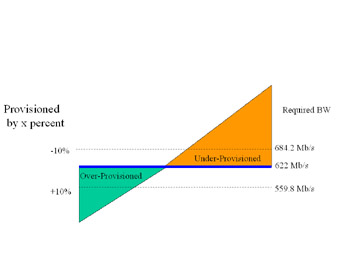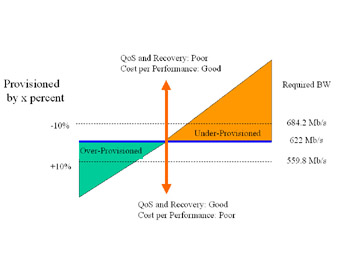Provisioning and Subscribing
|
| < Day Day Up > |
|
Before looking at the simplified math processes for engineering traffic in an MPLS tunnel, we need a brief discussion of bandwidth provisioning and subscribing.
First, let's look at the definitions of pertinent terms. Over-provisioning is the engineering process in which there are greater bandwidth resources than there is network demand. Under-provisioning is the engineering process in which there is greater demand than there are available resources. Provisioning is a term typically used in datacom language.
In telecom language, the term subscribe is used instead of provision. Over-subscribing is having more demand than bandwidth; under-subscribing is having more bandwidth than demand. It is important to note that provisioning terms and subscription terms refer to opposite circumstances.
A pipe/path/circuit that has a defined bandwidth (e.g., a Cat-5 cable) can in theory process 100Mb/s, while an OC-12 can process 622Mb/s. These are bits crossing the pipe, comprising all overhead and payload bits.
In order to determine the data throughput at any given stage of transmission, you can measure the data traveling through a pipe with relative accuracy using networking measurement tools. Using an alternate measurement method, you can calculate necessary bandwidth by calculating the total payload bits-per-second (bps) rate and adding the rate of overhead bps; this second method is more difficult to calculate and less accurate than actually measuring the pipe.
If the OC-12, which is designed to handle 622Mb/s, is fully provisioned and the traffic placed on the circuit is less than 622Mb/s, it is said to be over-provisioned. By over-provisioning a circuit, true QoS has a better chance of becoming a reality; however, the per-performance cost is significantly higher.
If the traffic that is placed on the OC-12 is greater than 622Mb/s, it is said to be under-provisioned. For example, commercial airlines under-provision as a matter of course because they calculate that 10 to 15 percent of their customers will not show up for a flight. By under-provisioning, the airlines are assured of full flights; they run into problems, however, when all the booked passengers show up for a flight. The same is true for network engineering: If a path is under-provisioned, there is a probability that there will arise the problem of too much traffic. The advantage of under-provisioning is a significant cost savings; the disadvantages are loss of QoS and reliability.
In Figure 5.3, you can see that you can over- or under-provision a circuit in percentages related to the designed bandwidth.

Figure 5.3: Over-Provisioning vs. Under-Provisioning
Figure 5.4 illustrates that, as we over-provision, QoS increases, but so does cost. If you under-provision, QoS and reliability decrease, and so does the cost.

Figure 5.4: Comparison of Over-Provisioning and Under-Provisioning
|
| < Day Day Up > |
|
EAN: 2147483647
Pages: 138